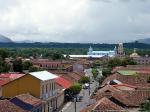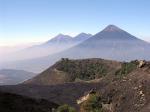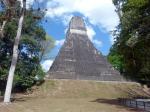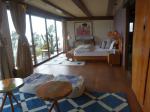In April I was invited to attend a trade event in El Salvador, and luckily I was able to take advantage of the opportunity and explore a bit more of Central America while there.Having only visited this part of Latin America once before on a trip to Costa Rica, on this trip I was taken aback by just how different all of its neighbours are.
Historical Nicaragua
On arrival in Managua, the capital of Nicaragua, travelled south straight to the lively beach town of San Juan del Sur. Popular among tourists and expats, this small town on Nicaragua’s Pacific coast would make a perfect stay to relax for a few days at the end of a trip to Nicaragua. The long stretch of beach, on which the town stands, is lined with busy seafood restaurants and bars which stay open long after the picturesque sunset that happens each evening. There are also several other nearby beaches, many of which have excellent waves for surfing.
I then continued on to Granada, a highlight for many in Nicaragua. This historical and colourful city on the shore of Lake Cocibolca is one of the oldest in the Americas, and it really does feel like taking a step back in time. Around the central plaza, horse-drawn carriages clip-clop along the cobbled streets and vendors sell their wares under the shade of trees. For an authentic experience, staying at Hotel Plaza Colón is a great option which is on the main plaza. While I was here I did a boat tour of the islets of Granada. Many of these islands are now private and have pretty holiday homes built on them, but others have quaint beaches and colonial forts, and one is inhabited solely by a family of monkeys! We also visited Granada’s Choco Museo to do a workshop all about the process of turning cocoa beans into chocolate, a culturally and historically significant delicacy in the region.
www.lastfrontiers.com/hotels/nicaragua/granada-and-ometepe/plazacolon
Next, I headed to León, Nicaragua’s second historically significant city. León is, in many ways, a sister city of Granada, with its well-preserved, colourful colonial architecture. However, León has more of a bohemian feel to it and its history is more associated with its deep connections to the Nicaraguan revolution. On the way here I stopped off at Old León, which today is really just a series of ruins, to learn about the origins of the settlement. The León which stands today was actually built after the evacuation of Old León. Natives were confused by the colonists’ decision to build a town directly under a volcanic vent, atop ground already covered by ash, but the foolishness of this placement did not become apparent to the Spaniards until it was too late. Walking around these ruins you learn a lot about life in the early stages of the Spanish colonial period, and the profound impact the Europeans had on native populations.
Nicaragua is well connected with Costa Rica by land, making this quite an easy and popular combination!
Nature and Ruins in El Salvador
While I was at the event in El Salvador I did have some free time to do a bit of exploring and see some of what this small country has to offer. I was not sure what to expect in El Salvador, since it only recently transitioned from “that scary place on the news” to “the safest country in Latin America”, but I was very pleasantly surprised by my experience there. The country is full of warm, friendly people, and they are all keen to get the tourism industry back up and running again. During my short stay I was able to visit San Salvador’s charming old town, and get out of the city to see the ruins at Joya de Cerén and Lago de Coatepeque. The landscapes are impressive, with large open plains and towering volcanoes, and El Salvador has a rich cultural history. With flights operating via Madrid to San Salvador, the country makes for a great destination to spend at least a few days in for people looking to experience some of the lesser travelled parts of the region, even if it’s just to break up the journey to another Central American country like Nicaragua.
Colonial towns and Pre-Columbian Temples in Guatemala
I took a flight to Guatemala City where I was then driven to the former capital of Guatemala, Antigua. This is one of the best-preserved colonial cities in Central America, and it has a lot more to offer tourists than the modern capital. This area is especially famous in Guatemala for its colourful traditional dresses, which are still being worn today. Here locals can tell which town people come from by looking at the intricate patterns woven into their clothing. In Antigua, I did a Streets and Eats tour to sample some of the incredible street food and experience a bit of the local life. We visited the buzzing market, which is open on Mondays, Thursdays and Saturdays, and seems to stretch on endlessly. We also stopped in at the bus station to look at the busses, which might not sound like an exciting excursion, but the souped-up US school busses in Guatemala really are a sight to behold!
No holiday in Guatemala could be complete without seeing the ancient Maya ruins at Tikal, which I found to be a real highlight of my trip. I stayed overnight on Isla de Flores, which is about an hours’ drive from the entrance to the national park. After meandering through the park for around an hour, the jungle opens up and you catch your first glimpse of the temple of The Great Jaguar, the most iconic structure in Tikal, which is impressively steep and tall. Some structures have wooden steps where you can walk to the top, which can be hard work in the heat and humidity of the jungle but it is absolutely worth it for the views of this sacred site.
My last stop in Guatemala was Lake Atitlán at the beautiful Casa Palopó, in a tranquil corner of the lake with stunning views out over the water. Here I did a tour of a few of the towns that sit on the lake's shores. Travelling around the lake is usually done by water taxi, and it takes about half an hour to cross from one end to the other. What’s interesting about the towns on the lake is that each one is strikingly unique, which makes for an interesting day out exploring the different areas. Some towns are colourful and exciting, with live music in the streets and multicoloured hats hanging everywhere, while others are more quiet and relaxed. My tour also included a visit to the famous effigy of San Maximón, Santiago Atitlán’s cigarette smoking saint, which resides in a different private home every year to stay hidden from the Catholic church.
The most popular combination which includes Guatemala is with Belize, and this crossing is usually done by land after visiting Tikal in the North East.
www.lastfrontiers.com/hotels/guatemala/lake-atitlan/casapalopo
For those who have perhaps already visited the region and are looking for new, lesser-travelled experiences, I would absolutely recommend a trip visiting one or more of these countries. Aside from the areas I visited, each place has a lot more to experience and more information can be found on our country pages.








